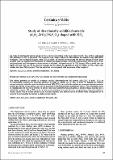Por favor, use este identificador para citar o enlazar a este item:
http://hdl.handle.net/10261/3983COMPARTIR / EXPORTAR:
 SHARE
BASE SHARE
BASE
|
|
| Visualizar otros formatos: MARC | Dublin Core | RDF | ORE | MODS | METS | DIDL | DATACITE | |

| Título: | Study of directionally solidified eutectic Al2O3-ZrO2(3%Y2O3) doped with TiO2 |
Otros títulos: | Estudio del eutéctico Al2O3-ZrO2 (3% Y2O3) dopado con TiO2 obtenido por solidificación direccional | Autor: | Diez, J. C. CSIC ORCID; Madre, M. A. CSIC ORCID; Sotelo, Andres CSIC ORCID; Peña, J. I. CSIC ORCID | Palabras clave: | Al2O3-ZrO2 Eutectic Directional solidification TiO2 doping Eutéctico Solidificación direccional TiO2 |
Fecha de publicación: | may-2007 | Editor: | Sociedad Española de Cerámica y Vidrio | Citación: | Boletín de la Sociedad Española de Cerámica y Vidrio 46(3): 119-122 (2007) | Resumen: | [EN] An study of directionally grown samples of the eutectic composition in the Al2O3-ZrO2 (3 mol% Y2O3) system, with small TiO2 additions (1 wt%), is presented. The microstructural changes induced by this addition are analysed using SEM (EDX) techniques. The mechanical changes, when TiO2 is added, are studied by measuring the flexural strength by three point bending. Also, the toughness is determined by Vickers indentation method. When slow growth rates (10 mm/h) are used, interpenetratred and homogeneous microstructure is obtained, independently of the TiO2 doping. When growth rates are higher (300 and 1000 mm/h) the structure changes and the phases are organized in form of colonies or cells, which have smaller size when TiO2 is present. This size reduction is accompanied with an increase of the toughness. [ES] Este trabajo presenta un estudio de muestras crecidas direccionalmente del sistema Al2O3-ZrO2 (3 mol% Y2O3) en su composición eutéctica con pequeñas adiciones de óxido de titanio (1% de TiO2 en peso). Se analizan los cambios microestructurales inducidos por esta adición mediante SEM (EDX) y se estudian los cambios en su comportamiento mecánico medido por flexión en tres puntos, así como la tenacidad de fractura mediante indentación Vickers. Con velocidades lentas de solidificación (10 mm/h) se obtiene en ambos casos una microestructura homogénea e interpenetrada, mientras que a velocidades mayores, 300 y 1000 mm/h, se forma una estructura en las que las fases se organizan en forma de colonias o células, siendo éstas de menor tamaño en las muestras dopadas. Esta disminución en el tamaño viene acompañada de un aumento de la tenacidad de fractura medida por indentación. |
Versión del editor: | http://boletines.secv.es/es/index.php?id=24&vol=46 | URI: | http://hdl.handle.net/10261/3983 | ISSN: | 0366-3175 |
| Aparece en las colecciones: | (ICMA) Artículos |
Ficheros en este ítem:
| Fichero | Descripción | Tamaño | Formato | |
|---|---|---|---|---|
| eutectico.pdf | 237,95 kB | Adobe PDF |  Visualizar/Abrir |
CORE Recommender
Page view(s)
290
checked on 18-abr-2024
Download(s)
100
checked on 18-abr-2024
Google ScholarTM
Check
NOTA: Los ítems de Digital.CSIC están protegidos por copyright, con todos los derechos reservados, a menos que se indique lo contrario.
